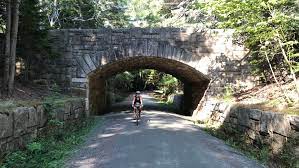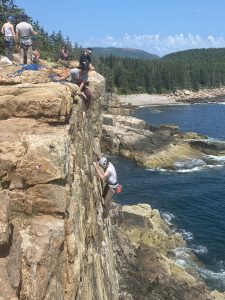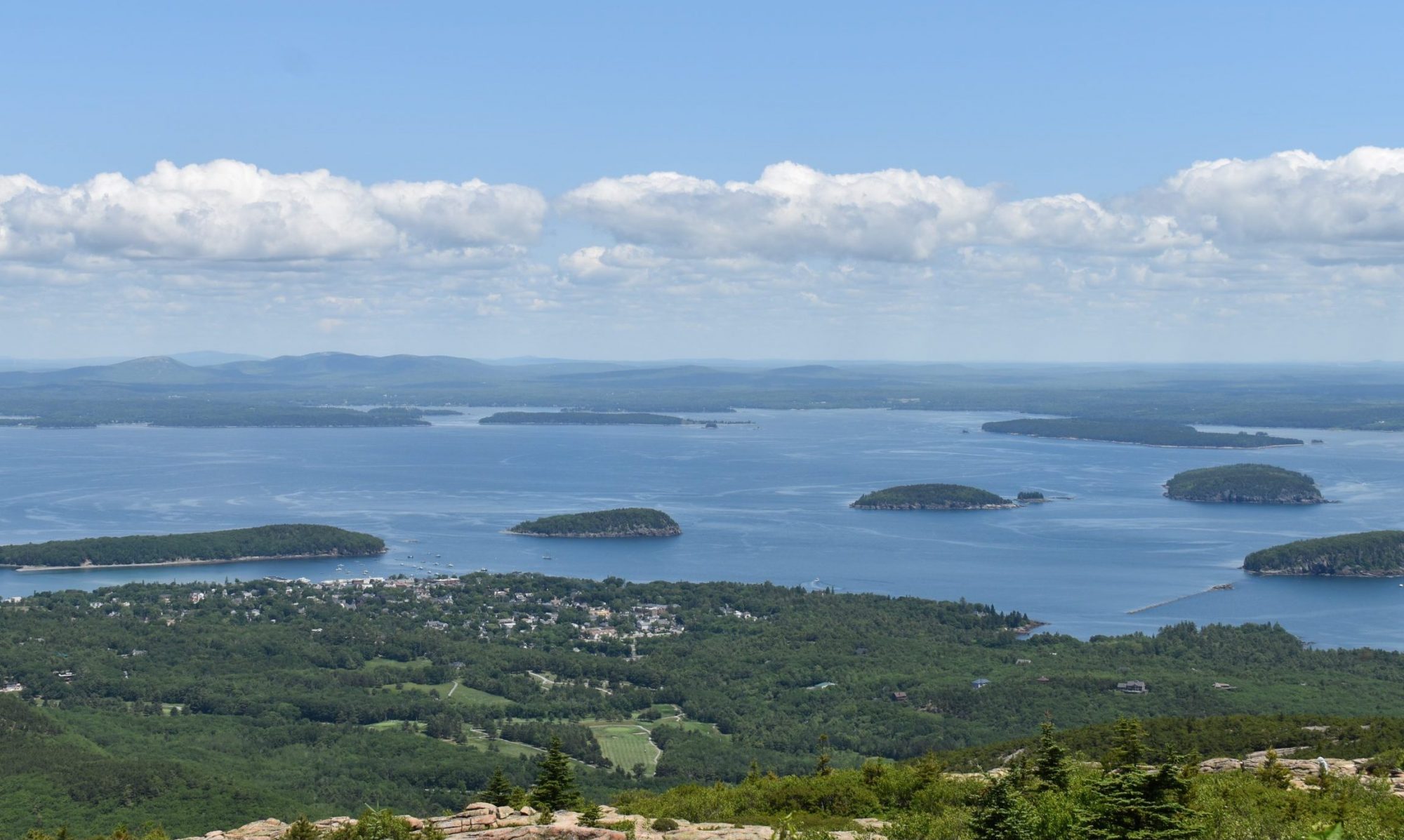Hiking
 Acadia National Park has over 158 miles of hiking trails to explore. Because of this, it is one of the most enjoyed form of recreation in the Park. From ocean views to mountain peaks and forests, there is a trail for all hiking abilities. Many of Acadia's hiking trails are very short and can be strung together to create longer and more interesting hiking loops. Though most of the hiking in Acadia takes place during the spring, summer, and fall, winter hiking is also a common occurrence.
Acadia National Park has over 158 miles of hiking trails to explore. Because of this, it is one of the most enjoyed form of recreation in the Park. From ocean views to mountain peaks and forests, there is a trail for all hiking abilities. Many of Acadia's hiking trails are very short and can be strung together to create longer and more interesting hiking loops. Though most of the hiking in Acadia takes place during the spring, summer, and fall, winter hiking is also a common occurrence.
Some of Acadia's most well-known trails are the Precipice and the Beehive Trails. These trails have metal rungs and ladders and are not for those afraid of heights. They do, however, get quite crowded and often create a less enjoyable hiking experience. If you are looking for an adventurous and less crowded adventure with rungs and ladders, try the Ladder Trail or the Beech Cliff Loop.
The park is also known for their scenic trails such as Ocean Path and the Ship Harbor Nature Trail. These are easy hikes for those who simply want to go for a stroll and enjoy nature. Ocean Path even goes by a handful of the popular attractions of the park such as Sand Beach, Thunder Hole, and Otter Cliffs.
Going on a Hike?
Find out about some helpful hiking tips and tricks, hiking safety precautions, and more using the links below.
Bicycling
Acadia National Park has a variety of bicycling options including the famous carriage roads, bike paths, gravel roads, and paved roads. Of these different terrain options there are also a variety of difficulties based on elevation change, distance, etc. The most popular biking routes are Acadia's carriage roads and Park Loop Road.
The carriage roads run through the heart of Acadia and have a crushed rock surface that is perfect for bicycling. Here you will find a map of the carriage roads.
 Etiquette for bikers on carriage roads include:
Etiquette for bikers on carriage roads include:
-
- Sharing the road with horses and pedestrians.
- Class 1 E-bikes are permitted, but class 2 and 3 are not.
- The bicycle speed limit is 20 mph.
- Respect all posted signs and notices - especially during mud season.
Park Loop Road is a paved road with narrow, winding, and congested sections. Biking during the busiest part of the day (10am to 4pm) is not advised. Though the road has beautiful scenic views, it can be dangerous and the Park Loop Road map (found here) should be thoroughly examined before embarking on your bicycling journey. Remember to bring your entrance pass as it is needed to bike on the Park Loop Road.
Planning on a Bike Ride?
Find out about bicycling on the Carriage Roads and Park Loop Road using the links below.
Rock Climbing

Because of its rich geological background, Acadia is home to a collection of fun rock climbing crags. From lowering off the edge of Otter Cliffs to climbing up the Bubbles, there is a climbing opportunity for people of all skill levels. The climbs are primarily trad and top rope oriented, but there are a few sport climbs with bolts.
If you have never climbed before, there are climbing schools and guides in the Bar Harbor area that will take you climbing for the day. The two most popular climbing schools/guides are Acadia Mountain Guides Climbing School and Atlantic Climbing School. Both are located in Bar Harbor and have a wide variety of options and rates depending on what you are looking for.
Look at These Rocks!
Find out about rock climbing safety and more using the links below.
Horseback Riding
In the colonial history of Mount Desert Island, horses facilitated many modes of transport, both functional and sporting. Indeed, the prevalence of equestrianism inspired the creation of the aptly named carriage roads in the 20th century. Since the invention of motorized vehicles, the park has moved past the need for horses as a form of transport. However, horseback- and carriage-riding remain prevalent as popular recreational activities on the island. Various proprietors around Acadia offer scenic rides around the carriage roads, as well as other suitable paths around the park. Horseback- and carriage-riding are an excellent way to experience the island through a historical lens.
Want to Try Horseback Riding?
Find out about Wildwood Stables, riding on the Carriage Roads, and more using the links below.
Water Activities
An essential part of Acadia's beauty is its proximity to the Atlantic ocean. High ocean cliffs, babbling brooks, secluded coves, and mountain lakes are all characteristic of Acadia's natural landscape. As such, many visitors hope to engage with the park's water features during their stay through a variety of recreation activities.
Swimming: Due to the chilliness of the ocean water, visitors seeking a refreshing dip tend to seek inland lakes and ponds. Echo Lake is by far the most popular swimming spot, However, several of the island's bodies of water, including Bubble Pond, Eagle Lake, Jordan Pond, act as public reservoirs, meaning you cannot swim in them. Always observe posted signage and ask a park ranger if you have any questions! For thrill-seekers interested in a cold ocean dive, Sand Beach and Seal Harbor Beach are the best places to do this, provided that proper safety precautions are observed.
Small boating and paddleboarding: Kayaking, canoeing, and paddleboarding are popular ways to observe Acadia's stunning coastal scenery. For beginners, the inner lakes and ponds of Mount Desert Island are great places to participate in these activities: consider Long Pond, Eagle Lake, Echo Lake, or Jordan Pond, for instance. As for the ocean, many companies offer guided ocean kayaking tours to explore the outer borders of Mount Desert Island. Exercise caution in independent ocean excursions, as the cold temperatures of the water are hazardous at all times of year. Per state law, always remember your life jackets!
Large boating: There exist plenty of motorized or sailboat tours of the coastal areas around Mount Desert Island. These are great ways to see the natural landscape of the coast as well as oceanic wildlife such as puffins, whales, and lobsters, on specialized cruises.
Going for a Swim?
Find out about swimming and boating opportunities on Mount Desert Island using the links below.
Wildlife Viewing
Acadia is home to a diverse ecosystem of flora and fauna, such that it is nearly impossible to spend time in the park without interacting with them on some level.
Woodland creatures: Many small mammals scurry around the underbrush in Acadia, including squirrels, rabbits, and voles. It is quite likely to come across wildlife like this in typical park exploration. Encounters with larger creatures require some amount more good luck (or bad luck, depending on your perspective) to occur. Bears, foxes, coyotes, or the elusive moose have all rarely been spotted around Acadia. Consult the NPS guidance on what to do in such a wildlife encounter; remember to keep your distance and keep your food to yourself!
Birdwatching: Over 330 species of birds frequent Mount Desert Island, making it a great spot to birdwatch. From mountain peaks such as Cadillac or Dorr mountain, the astute observer may spot falcons, eagles, warblers, or terns. Closer to the water, the oceanic birds of Acadia are also impressive, from ospreys to shearwaters to guillemots. For visitors particularly interested in puffins, boating tours regularly go out from Bar Harbor to small islands where the seabirds can be observed in great numbers. Overall, the soundscape of Acadia is filled with chirping of birdsong wherever you go.
Marine mammals: The best way to see the whales and seals off the coast of Maine is to take a specialized boating expedition to the places they are known to frequent. Humpback whales, right whales, finback whales, and minke whales can all be found this way in the appropriate season. You may also be able to catch a glimpse of harbor or grey seals if that's more up your alley.
To learn more about all these kinds of animals, and the efforts to protect them, from the safety of the indoors, consider a visit to the George B. Dorr Natural History Museum outside of Bar Harbor.
Want to Engage with your Natural Surroundings?
Find out about where to see and even photograph the beautiful nature of Acadia using the links below.
Stargazing
When the sun sets on Acadia, the park experiences impressively little light pollution, making it a perfect environment for stargazing. Learn more about the park's efforts to maintain dark skies here.
When deciding when to go stargaze, consider moon phase, weather, and the timing of sunset and/or sunrise.
Sand Beach is a popular spot to observe the stars and is often home to photographers capturing long-exposure images of the night sky. For a less trafficked spot, consider Seawall picnic area on the west side of the island. However, most of the park is shrouded in sufficient darkness that anywhere outside the main towns with a view of the sky is likely to be breathtaking.
Ever Seen a Shooting Star?
Find out about where to see the Milky Way and more using the links below.

